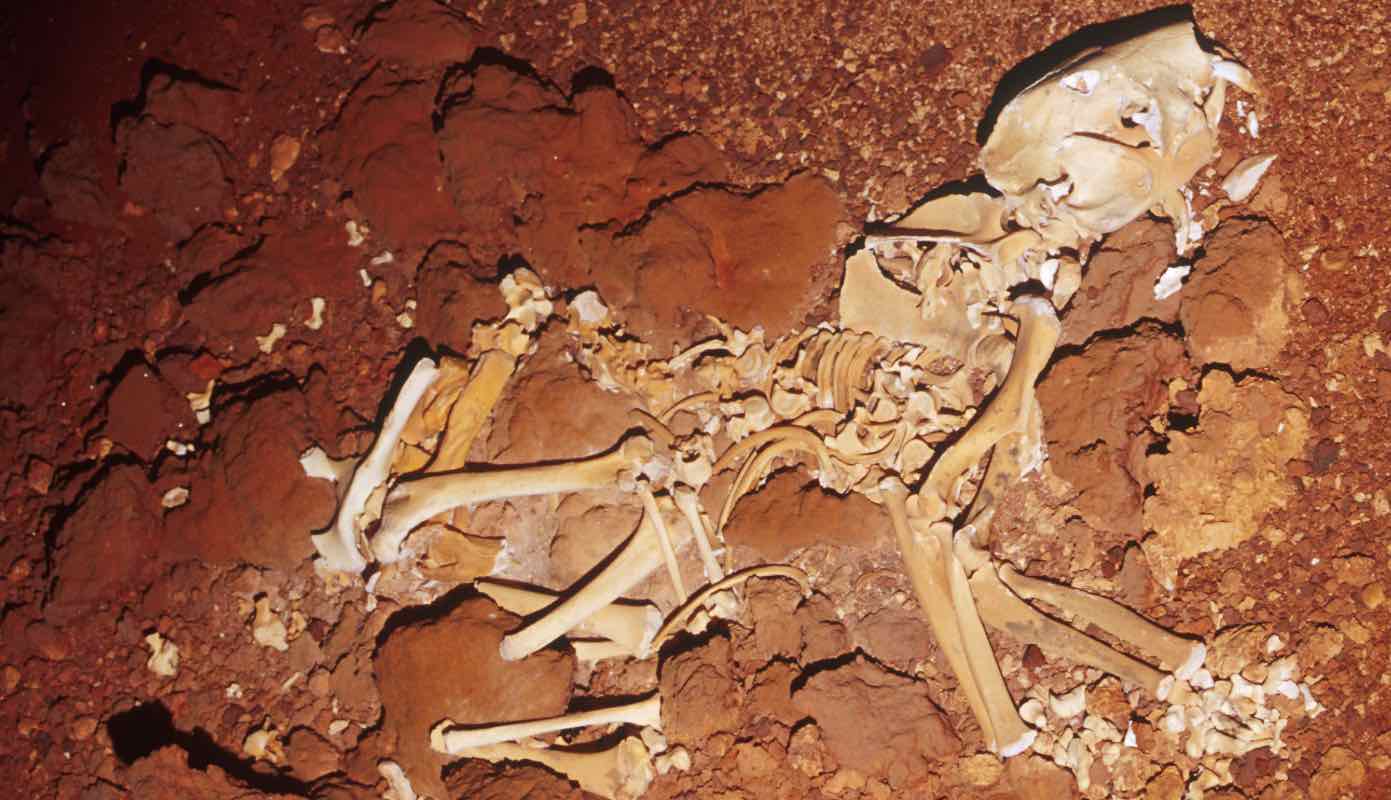
Transport yourself 50,000 years into the past, and you’d see that the Australian landscape of the Late Pleistocene wasn’t all that different from today’s. Upon leaving your time machine, however, you might wonder if the waters brimmed with steroids. Many of the creatures that prowled the ancient outback were both strange and supersized, including a wombat-like marsupial the size of a Mini Cooper and a gargantuan turtle with a horned head and spiked tail.
But perhaps none of the Australian megafauna was quite as unusual as Thylacoleo carnifex, commonly known as the marsupial lion. The jaguar-sized mammal was first described in the mid-1800s, but 150 years later, paleontologists still found themselves without a complete skeleton. And what bones they did cobble together presented a baffling paradox.
“This is an animal that looked and moved and behaved completely different to anything that’s around today,” explains study author Aaron Camens, a paleontologist at Flinders University in South Australia. “It’s a mashup of a bunch of marsupials.”
T. carnifex was the product of a long line of herbivorous marsupials, but its odd assortment of carnivorous features, including a set of enormous, blade-like premolars, pointed to a potentially predatory lifestyle.
Today, a team of Australian researchers unveils the first complete skeletal reconstruction of T. carnifex. Thanks to a set of newly unearthed fossils, including the first known T. carnifex collarbone and tail bones, the marsupial lion is now whole, allowing scientists to assess its body in its entirety. According to the study, T. carnifex was a carnivore adept at both hunting and scavenging—but its considerable bulk indicates that, in nearly all respects, the marsupial lion was actually far from feline.
“This study provides the most detailed analysis to date of the likely hunting behaviors of the most highly adapted mammalian predator Australia has ever had,” says Natalie Warburton, a zoologist who studies extinct Australian megafauna at Murdoch University in Australia and frequently collaborates with the authors, but did not contribute directly to the new study.
The unique features of Thylacoleo carnifex—whose name translates loosely to “meat-cutting pouched lion”—began with a mouthful of contradictions. Big incisors, tiny canines, and strong cheeks built for hefty munching aligned with its herbivorous ancestors. But further back in its mouth, the gargantuan, scissor-like premolars decorating its jaws seemed tailor-made for flesh. Researchers believe T. carnifex also had the strongest bite of any known mammal, living or extinct—likely overkill for nibbling on grass or foliage.
Even more puzzlingly, the marsupial lion wasn’t a member of the group that gave rise to more modern carnivorous marsupials, like the Tasmanian devil (Sarcophilus harrisii) and the now-extinct thylacine (Thylacinus cynocephalus). Instead, it’s believed to have been a descendant of the mammalian branch that gave rise to koalas, kangaroos, and wombats—which, Camens says, would make T. carnifex the only true carnivore of its lineage.
As such, the diet of T. carnifex spawned heated debate for years: Paleontologists speculated that this ancient marsupial gnawed on everything from crocodile eggs to melons. And while the carnivore theory gained more traction in the latter half of the 20th century, with so few bones to go on, researchers remained unsure how exactly T. carnifex moved and interacted with its environment. But the new specimens, discovered in Naracoorte and the Nullarbor Plain of southern Australia, finally allowed scientists to tie up some longstanding loose ends.
By analyzing the composite remains of T. carnifex and comparing them to living mammals, Camens, along with study author Roderick Wells, a paleontologist and ecologist also at Flinders University, confirmed that the marsupial lion really wasn’t built much like a lion. While the bodies of big cats are sleek, lithe, and well-suited to the chase, T. carnifex was more of a bodybuilder than a runner. Thickly muscled even through its rigid lower back and robust, inflexible tail, T. carnifex may have braced its 200-plus-pound body on its tail and hind limbs like the tripod of a camera, the researchers believe.
“How stiff-backed it is is really exciting,” says Christine Janis, a mammalian paleontologist at the University of Bristol in the United Kingdom who did not participate in the research. “It puts limits on its behavior. This was not a leaping, running animal.”
The front half of T. carnifex also diverged substantially from its feline namesake. While many predatory cats have lost or modified their clavicles to afford them flexibility, T. carnifex had firmly anchored collarbones and shoulder blades that may have strengthened its versatile forelimbs. And, crouched on its hind legs, the marsupial lion likely made good use of its hands—aptly named because this peculiar creature boasted clawed, opposable thumbs.
Camens thinks T. carnifex used these deadly digits to adroitly grasp and restrain prey. “That opposable thumb was an advantage, and crucial in capture,” he says. “There’s nothing else we see that uses this same method of hunting.”
A tight grip probably came in handy for climbing, too. Though researchers think it’s unlikely to have spent its days aloft, they believe T. carnifex was dexterous enough to scale trees, and potentially used these lofty vantage points to leap down onto unsuspecting prey.
Such a tactic might have been necessary, considering T. carnifex’s cumbersome brawn: The marsupial lion was probably an ambush predator, capable of only short bursts of activity. And T. carnifex actually couldn’t open its jaws very wide, meaning it probably relied on the efficiency of its clawed digits and razor-sharp bite. Though it made for a tight fit, the marsupial lion’s mouthy guillotine was probably capable of severing spinal cords, crushing wind pipes, or dismembering the feet of fleeing prey.
“All the evidence we now have was that it was Australia’s top marsupial carnivore,” Wells explains. Though, he notes, T. carnifex wasn’t necessarily a prey-to-plate snob: It probably wouldn’t have turned its nose up to the convenience of scavenging.













